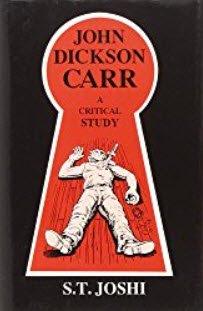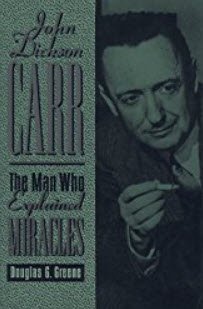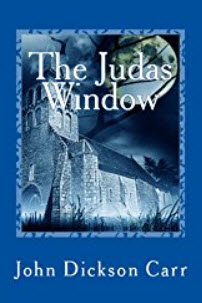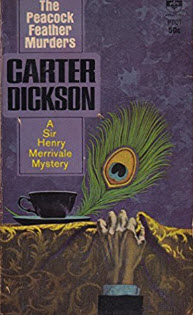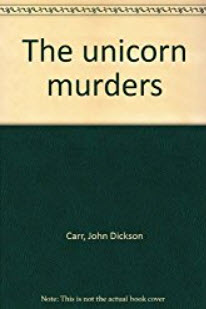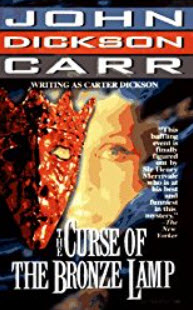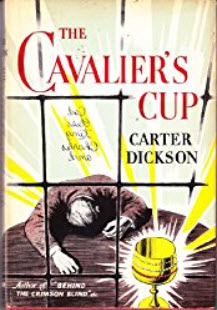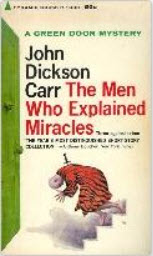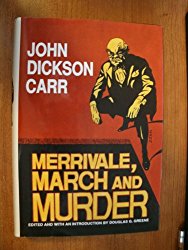Sir Henry Merrivale
"You can argue as you will about which was the most enjoyable period for a reader of detective stories: My allegiance remains irrevocably fixed to the 1930's, when you could count on four new novels a year by John Dickson Carr."
-- Anthony Boucher
Sir Henry Merrivale is one of the world's most beloved detectives by aficionados of detective, crime, and murder mystery books.
John Dickson Carr was so prolific that there came a time when his publisher (Harper & Brothers) asked him to slow down. His response was to keep his commitment to Harper & Brothers by continuing his output for the books he promised them. But once this ongoing, annual commitment was fulfilled, he brought new material to publishers William Morrow.
A new detective, John Gaunt, appeared only in The Bowstring Murders (1933). But Carr also created Sir Henry Merrivale (a.k.a, H.M. or "the Old Man"), who was to develop into a series detective (22 books over the next 35 years).
|
The books published by Harper were under Carr's real name. Wishing to avoid a conflict between the two publishers, he wanted a pseudonym that would be unrecognized as his. Carr suggested to Morrow that they publish his books written for them under the name "Christopher Street." The name was taken from a street in New York's Greenwich Village, which he discovered when he lived there with his wife, Clarice Cleaves. (Note: In John Dickson Carr: A Critical Study, Copyright ©1990 by Bowling Green State University Popular Press, S.T. Joshi says, "Carr wished to use the pseudonym Nicholas Wood, derived from his father's first two names.") |
Click Image to Click the image below to |
Carr and Harper & Brothers were miffed when the book was published under the name Carr Dickson, from which he could easily be identified as the author. Morrow published later books under the name Carter Dickson.
120 Plots
|
Regarding Carr's prodigious output, Douglas Greene mentions an anecdote about Henry (Tommy) Tomlinson and Robert Lewis Taylor: "Tomlinson told Taylor that on one occasion he asked Carr if he had any trouble devising plots. 'I've had exactly one hundred and twenty plots outlined, for emergencies,' Carr answered, 'since I was eleven years old'" (Douglas Greene, John Dickson Carr: The Man Who Explained Miracles, New York: Otto Penzler Books, 1995, p. 75). |
Click Image to Click the image below to |
Taylor included this anecdote in an article about Carr, "Two Authors in an Attic," that was published in New Yorker Magazine. It was confirmed by Edward Delafield in a letter (dated February 13, 1982) to Greene (John Dickson Carr: The Man Who Explained Miracles, Chapter 3, note 41, pp. 75, 499).
Humor in the H. M. Novels
John Dickson Carr was influenced by his reading P. G.
Wodehouse's books. So much so, in fact, that several early reviewers
thought Wodehouse was the author of some of Carr's books.
Regarding humor and comedy in the Merrivale books, Greene tells us:
| Readers familiar with all twenty-two Sir Henry Merrivale novels are apt to regard him as one of the greatest of comic detectives, whose antics frequently descend to (or rise to) slapstick. But he does not start out that way in The Plague Court Murders. In that novel and the other early volumes of his casebook, the humor is in H.M.'s language and in his occasional tantrums; he rarely does anything funny, and there is nothing comic about the mystery. (Greene, John Dickson Carr: The Man Who Explained Miracles, p. 128.) |
In the introduction to The Judas Window (New York: William Morris and Company, Inc., 1938 -- the1987 International Polygonics, Ltd. edition) by Carter Dickson (pseudonym of John Dickson Carr), Douglas G. Greene writes:
| In later books, Carr broadened H.M.'s character so that he becomes almost a buffoon. Almost, but not quite. Even when he is dictating scurrilous memoirs, or taking singing lessons, or learning to play golf, or chasing a wheeled suitcase down a hill, or calling distinguished members of the government "Horseface," "Old Boko," and "Squiffy"--even at those times he remains, as he calls himself, "the Old Man," who can by "sittin' and thinkin'" discover the truth behind an apparently inexplicable crime. |
The Peacock Feather Murders (New York: William Morrow and Company, Inc., 1937, chapter 7) by Carter Dickson (International Polygonics, Ltd. 1987 reprinted version) gives us a taste of H.M.'s "buffoonery":
| H.M. stood the dinners to his two companions; he handsomely (ghoulishly, an outsider might have thought) offered to drive them in his own car to the tavern. The experience was not as bad as might have been expected. Despite H.M.'s taste for speed, their pace was moderate, even partaking of a mysterious jerkiness which startled traffic-policemen; but in justice to their own necks Pollard refrained from pointing out that the car would function better with the hand-brake off. They jumped along the streets like a mechanical toy, H.M. with a sort of wooden sneer in his own pride, and a good dinner restored them all. |
Another brief example is in The Cavalier's Cup: "When Sir Henry Merrivale took up singing lessons, it was agreed that this new pursuit might wreak incalculable harm on innocent people...".
|
Click Image to Click the image below to |
Click Image to Click the image below to |
Mystery in the Merrivale Books
But at the heart of each Sir Henry Merrivale book is a great mystery, often employing Carr's great skill at writing locked-room murder mysteries and impossible crimes.
Greene tells us, "Robert Adey, the greatest expert on the history of impossible crimes in fiction, calls H.M.'s case, The Judas Window, 'perhaps the best locked room novel ever written'" (John Dickson Carr: The Man Who Explained Miracles, p. 159) This is an interesting observation in light of the fact that The Three Coffins (a.k.a. The Hollow Man) -- featuring Carr's detective Dr. Gideon Fell -- has been identified by many experts as the best locked room mystery of all time.
|
In The Unicorn Murders, (by Carter Dickson, New York: William Morrow and Company, Inc., 1935, chapter 10), D'Andrieu says, "...there remains the question of which of two impossibilities we prefer. Very well. He could not have been shot, because that is impossible. The weapon could not have been used like a dagger or thrown like a spear, since to do this the murderer must have been invisible. That is impossible, too. Personally, I prefer the first alternative." |
The Henry Merrivale Books
The Sir Henry Merrivale books are:
- The Plague Court Murders (1934)
- The White Priory Murders (1934)
- The Red Widow Murders (1935)
- The Unicorn Murders (1935)
- The Punch and Judy Murders (1936) (The Magic Lantern Murders)
- The Peacock Feather Murders (1937) (The Ten Teacups)
- The Judas Window (1938) (The Crossbow Murders)
- Death in Five Boxes (1938)
- The Reader Is Warned (1939)
- And So to Murder (1940)
- Nine -- and Death Makes Ten (1940) (Murder in the Submarine Zone)
- Seeing Is Believing (1941) (Cross of Murder)
- The Gilded Man (1942)
- She Died a Lady (1943)
- He Wouldn't Kill Patience (1944)
- The Curse of the Bronze Lamp (1945)
- My Late Wives (1946)
- The Skeleton in the Clock (1948)
- A Graveyard to Let (1949)
- Night at the Mocking Widow (1950)
- Behind the Crimson Blind (1952)
- The Cavalier's Cup (1953)
|
Click Image to Click the image below to |
Click Image to Click the image below to |
Merrivale also appears in Carr's short story collection The Men Who Explained Miracles and in Merrivale, March and Murder (1991 -- compiled by Douglas Greene).
|
Click Image to |
Click Image to Click the image below to |
|
Douglas Greene also wrote the definitive biography John Dickson Carr: The Man Who Explained Miracles. |
Click Image to Click the image below to |
Amazon and the Amazon logo are trademarks of Amazon.com, Inc. or its affiliates.
(This is a link through which I make a small commission if you buy. See here for more details.)
